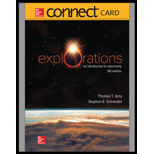
Concept explainers
Approximate mass and radius of a white dwarf compared to solar mass.
Answer to Problem 1QFR
White dwarf can have mass up to 8times the solar mass and nearly radius upto 1.4 times the solar radius.
Explanation of Solution
Normally, stellar evolution ends in three major ways. They are called proton star, neutron star and a blackhole. The criteria which determines the type of end stage is the mass and radius of star.
Among these, white dwarfs are small sized, high temperature stars. They have almost diameter near to that of Earth. Even they are very hot, due to very small surface are, they appear very dim compared to Earth. Even the brightest white dwarf has only brightness 1% of Sun. Surface temperature of white dwarf will be close to 10,000 K. It appears in bluish color.
White dwarfs are formed when its ejected stellar wind ends in planetary nebula. This happens for the stars having mass up to 8times the solar mass. Size of white dwarf is limited by the Chandrasekhar limit. Maximum radius of white dwarf would be 1.4 times the radius of Sun.
Conclusion:
Thus, the white dwarf can have mass up to 8times the solar mass and nearly radius upto 1.4 times the solar radius.
Want to see more full solutions like this?
Chapter 15 Solutions
EXPLORATIONS:INTRO.TO ASTRONOMY-ACCESS
- What is the defining difference between a brown dwarf and a true star?arrow_forwardApart from the masses, how are binary systems with a neutron star different from binary systems with a white dwarf?arrow_forwardIf the Sun were replaced by a white dwarf with a surface temperature of 10,000 K and a radius equal to Earth’s, how would its luminosity compare to that of the Sun?arrow_forward
 Foundations of Astronomy (MindTap Course List)PhysicsISBN:9781337399920Author:Michael A. Seeds, Dana BackmanPublisher:Cengage Learning
Foundations of Astronomy (MindTap Course List)PhysicsISBN:9781337399920Author:Michael A. Seeds, Dana BackmanPublisher:Cengage Learning Stars and Galaxies (MindTap Course List)PhysicsISBN:9781337399944Author:Michael A. SeedsPublisher:Cengage Learning
Stars and Galaxies (MindTap Course List)PhysicsISBN:9781337399944Author:Michael A. SeedsPublisher:Cengage Learning AstronomyPhysicsISBN:9781938168284Author:Andrew Fraknoi; David Morrison; Sidney C. WolffPublisher:OpenStax
AstronomyPhysicsISBN:9781938168284Author:Andrew Fraknoi; David Morrison; Sidney C. WolffPublisher:OpenStax An Introduction to Physical SciencePhysicsISBN:9781305079137Author:James Shipman, Jerry D. Wilson, Charles A. Higgins, Omar TorresPublisher:Cengage Learning
An Introduction to Physical SciencePhysicsISBN:9781305079137Author:James Shipman, Jerry D. Wilson, Charles A. Higgins, Omar TorresPublisher:Cengage Learning Stars and GalaxiesPhysicsISBN:9781305120785Author:Michael A. Seeds, Dana BackmanPublisher:Cengage Learning
Stars and GalaxiesPhysicsISBN:9781305120785Author:Michael A. Seeds, Dana BackmanPublisher:Cengage Learning Horizons: Exploring the Universe (MindTap Course ...PhysicsISBN:9781305960961Author:Michael A. Seeds, Dana BackmanPublisher:Cengage Learning
Horizons: Exploring the Universe (MindTap Course ...PhysicsISBN:9781305960961Author:Michael A. Seeds, Dana BackmanPublisher:Cengage Learning





